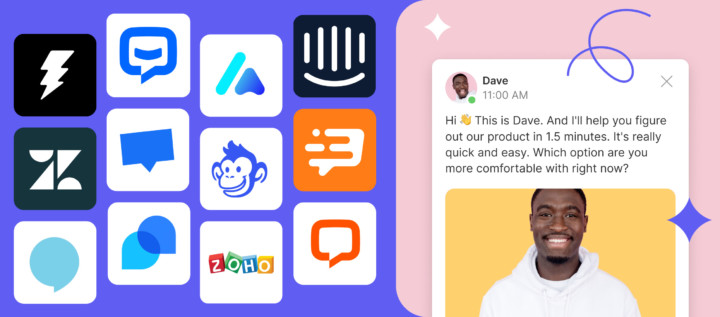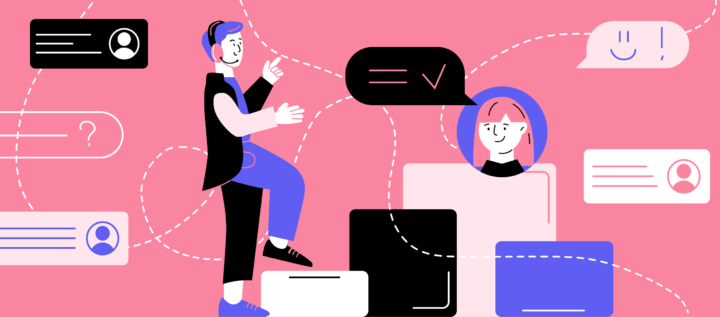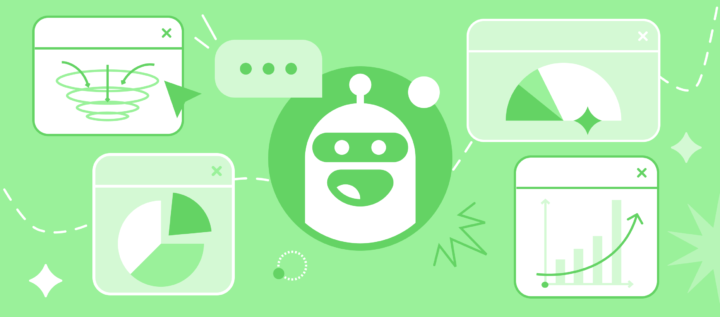Mastering customer retention management: A compassionate guide for your team

Overview
This article highlights the crucial role of mastering customer retention management for online services. We understand that running a business can be overwhelming, and effective strategies can truly make a difference in enhancing customer loyalty and profitability. By showcasing the economic advantages of retaining clients — like lower churn rates and increased lifetime value — we emphasize how personalized communication, exceptional service, and the smart use of technology can help you forge strong client relationships. Ultimately, these practices position your business for sustainable growth in a competitive market.
There’s no doubt that any team faces daily challenges of customer communication, and the pressure to keep customers coming back can feel immense. But the good news is that there are practical solutions available that can simplify these challenges. Think about how personalized communication can transform your customer interactions. It’s not just about selling; it’s about building connections that matter.
Imagine reducing churn rates and increasing the lifetime value of your customers. By focusing on exceptional service and leveraging technology, you can create an environment where clients feel valued and understood. This isn’t just a strategy; it’s a pathway to nurturing lasting relationships that foster loyalty.
So, what’s the next step? Start by evaluating your current customer retention strategies. Are they truly meeting your clients’ needs? Take small, actionable steps to enhance your approach. Remember, you’re not alone in this journey. Many small business owners share your concerns, and together, we can find ways to thrive in this competitive landscape.
Introduction
In the competitive landscape of small businesses, we understand that mastering Customer Retention Management (CRM) can feel overwhelming. As you strive to build lasting relationships with your customers, focusing on retention is not just about reducing churn rates; it’s about enhancing profitability and ensuring a steady revenue stream.
With consumer loyalty increasingly hinging on personalized experiences and exceptional service, it’s essential to adapt to meet evolving expectations. In this article, we will explore the importance of CRM, share effective strategies for enhancing customer loyalty, and introduce the technological tools that can simplify your retention efforts.
Together, we can position your small enterprise for sustainable growth in this dynamic marketplace.
Understanding Customer retention management: A foundation for success
Customer retention management (CRM) is about the strategies and processes organizations use to nurture customer loyalty and satisfaction over time. As we look towards 2025, it’s clear that effective customer retention management is more vital than ever for small businesses striving to thrive in a competitive landscape. By prioritizing customer retention, these companies can significantly reduce churn rates, boost profitability, and create a dependable revenue stream.
Building strong client relationships is at the heart of customer retention management. This not only cultivates brand loyalty but also meets consumer expectations, as studies show that a third of shoppers believe it takes three purchases to develop lasting loyalty. This underscores the importance of maintaining a robust connection with clients. Furthermore, with only 1 in 26 dissatisfied customers willing to voice their concerns, the ability to proactively manage client relationships through effective customer retention strategies becomes essential. Businesses must engage with their clients to prevent churn and understand their needs.
A case study on client service statistics highlights how effective service is crucial in customer retention management. Positive service experiences greatly influence client loyalty, repeat purchases, and brand allegiance. As CallMiner aptly notes,
Around 44% of clients want companies to ensure that service and support teams resolve their issues effectively and efficiently.
By focusing on these relationships and addressing challenges — like the notably low loyalty rates in education applications — companies can foster repeat customers through customer retention management, securing a competitive edge in the marketplace.
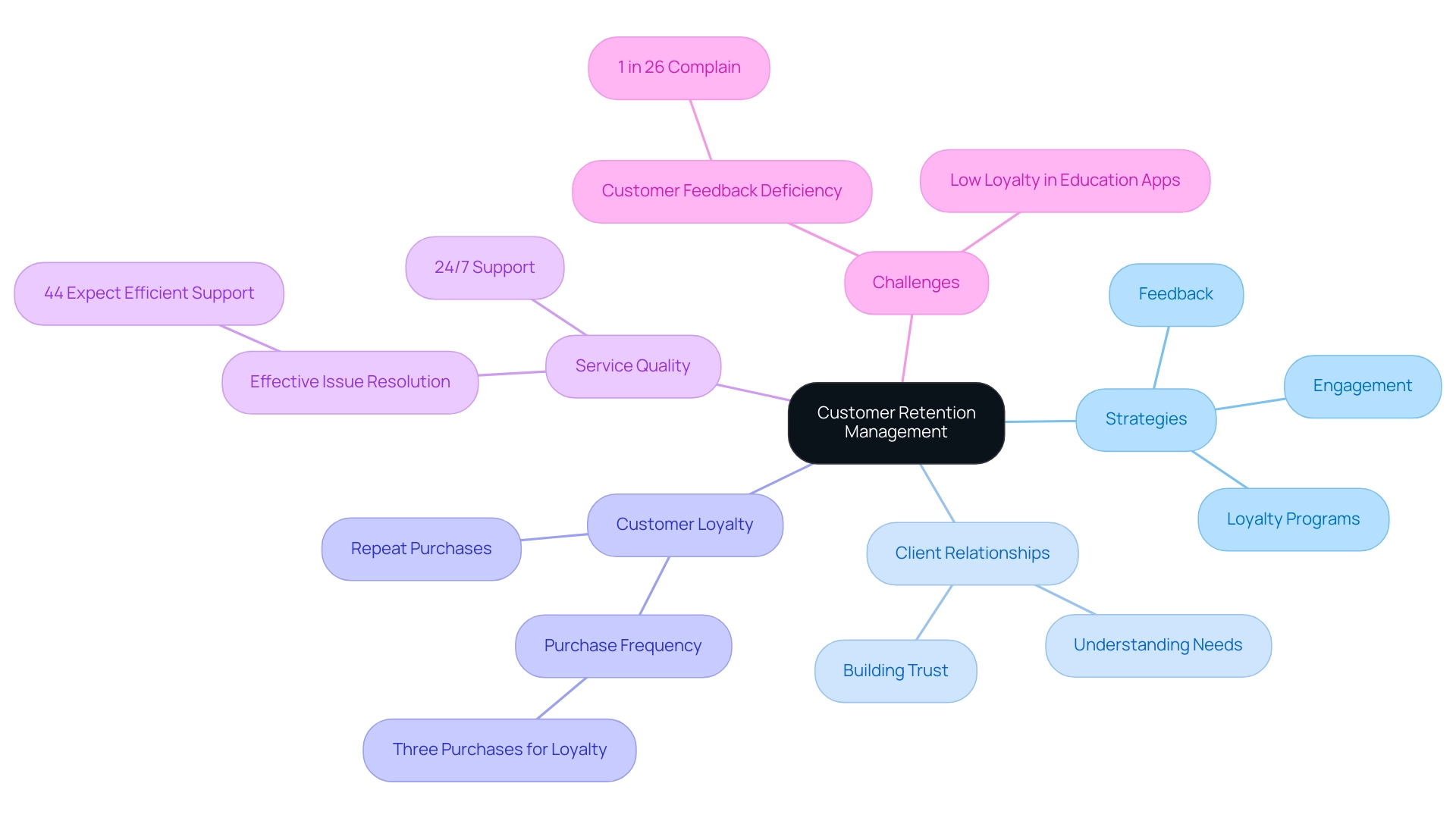
The importance of customer retention for small businesses
Keeping clients is essential for small enterprises. We understand that effective customer retention management is considerably more economical than gaining new ones. Did you know that a mere 5% rise in client retention rates can lead to profit increases ranging from 25% to 95%? This happens because devoted patrons not only tend to spend more over time but are also more likely to refer new clients to your establishment.
When relationships are established, they promote greater satisfaction among clients, which in turn lowers marketing expenses. By focusing on loyalty approaches, small enterprises can boost profitability. Implementing customer retention management fosters a devoted clientele that provides priceless feedback and insights for future growth. Remember, a strong emphasis on customer retention management isn’t just good practice — it’s a solid and sustainable strategy.
Moreover, utilizing tools like Dashly‘s AI support bot, which can manage up to 40% of user inquiries, can greatly enhance your preservation efforts through automation. The case analysis titled ‘Balancing Acquisition and Retention’ illustrates that companies must prioritize customer retention management. Finding equilibrium between attracting new clients and keeping current ones is vital. Emphasizing client loyalty alongside acquisition can lead to greater profits and enhanced relationships. This balanced method is crucial for sustained success in a progressively competitive environment. Top brands combine loyalty and acquisition tactics to ensure both devoted and new clients find value in their offerings.
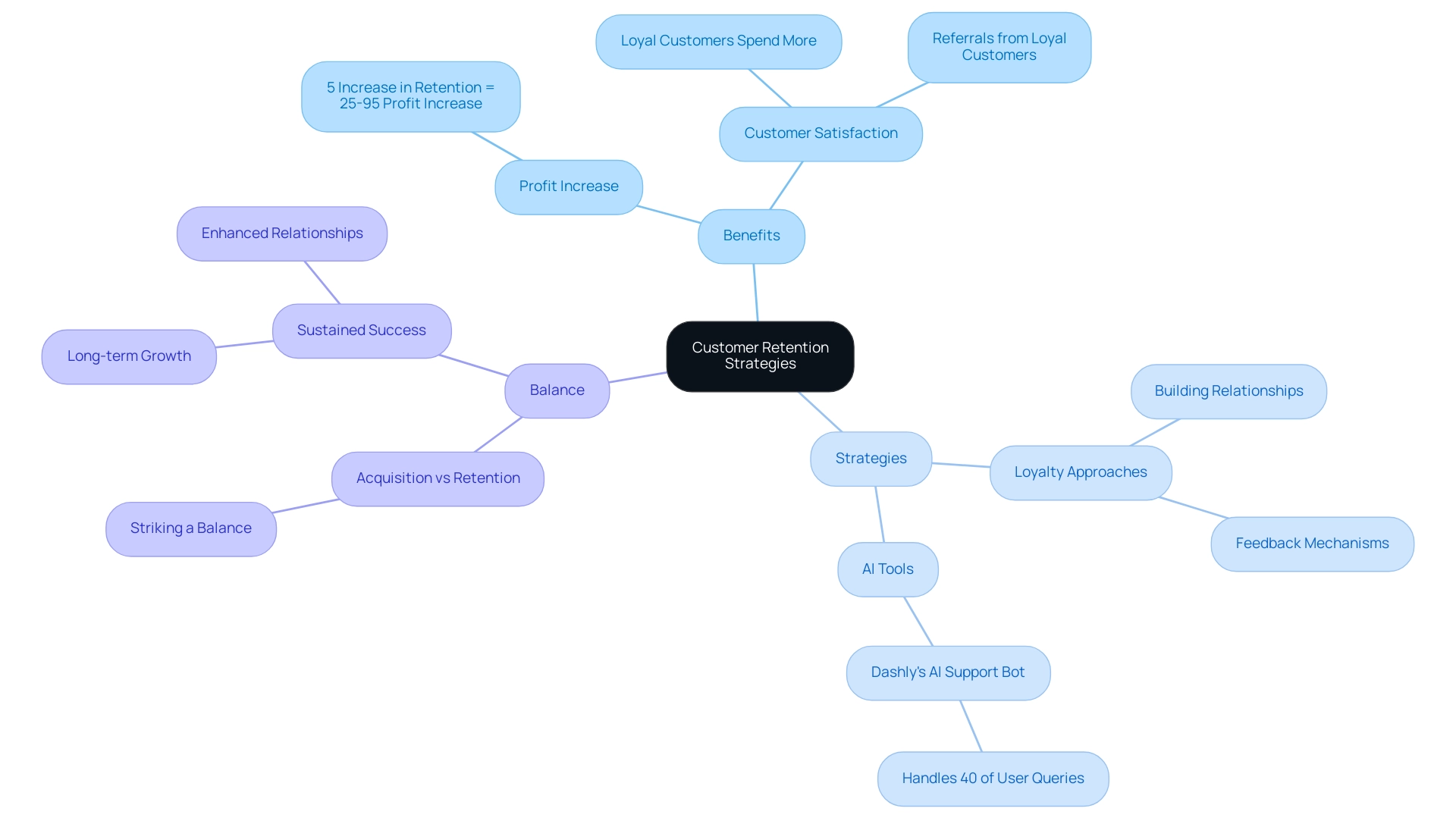
Effective strategies for enhancing customer retention
To bolster client retention, small businesses can implement several impactful strategies that truly resonate with their unique challenges:
- Personalized communication: It’s essential to develop tailored communications that reflect client preferences and behaviors. By utilizing advanced data analytics and Dashly’s user behavior tracking, you can segment your audience effectively. This allows for targeted messages that resonate with individual clients and foster deeper connections. Remember, 74% of clients indicate that their loyalty increases when they feel heard and understood by a brand — this is crucial for effective customer retention management.
- Loyalty programs: Consider designing a rewards program that incentivizes repeat purchases. Offering discounts, exclusive promotions, or a points system that clients can redeem for products or services enhances their engagement with your brand.
- Exceptional client service: Prioritize training your team to deliver outstanding service that goes above and beyond client expectations. With Dashly’s shared inbox, support staff can handle user queries from various channels, ensuring swift responses to inquiries and proactive assistance. This significantly enhances client satisfaction and loyalty. Plus, continuity in client interactions is maintained as agents can access the full history of conversations, allowing for informed and personalized support.
- Regular follow-ups: Implement a structured approach for checking in with clients post-purchase. Engaging them through emails, surveys, or phone calls shows that you value their feedback and opinions, ensuring their satisfaction with their experience.
- Soliciting feedback: Actively seek client input through surveys or direct communication channels. Using Dashly’s analytics, businesses can cohesively analyze interactions and feedback, helping to identify areas for improvement and making individuals feel acknowledged and appreciated.
- Educational content: Providing resources like tutorials, webinars, or how-to guides enables users to maximize the benefits of your products or services. This initiative, along with Dashly’s self-service options and AI support bot, strengthens their decision to engage with your brand and boosts their loyalty over time by allowing them to solve problems independently.
In 2023, global advertising and marketing expenditure increased by approximately 5% to over 1.65 trillion dollars, highlighting the significance of investing in client loyalty strategies alongside acquisition efforts. It’s noteworthy that numerous firms concentrate more on client acquisition (44%) than on customer retention management (18%), emphasizing the necessity for a balanced strategy. Furthermore, assessing client loyalty effectively can be illustrated through a case study that highlights the computation of client loyalty rates (CLR), which shows a loyalty rate of 94% for enterprises that actively monitor these metrics.
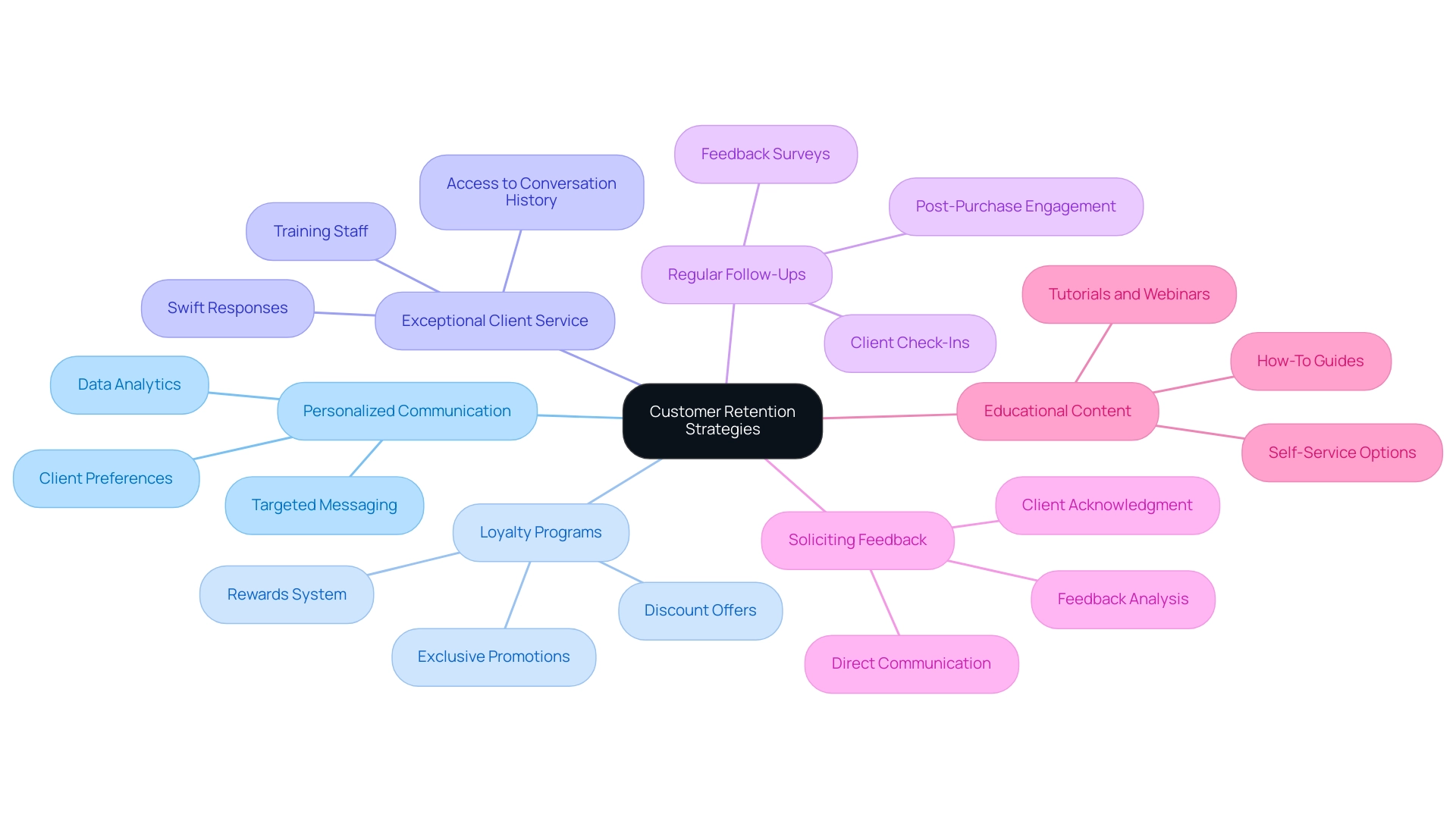
Leveraging technology for improved customer retention
Technology plays a crucial role in effective customer retention management, helping small businesses implement strong strategies. We understand the challenges you face daily, and here are some essential tools that can truly make a difference in your retention efforts:
Client Relationship Management (CRM) systems: A CRM platform allows you to track interactions, preferences, and feedback comprehensively. By centralizing this data, you can foster personalized communication and targeted marketing campaigns, which are vital for retaining customers. In fact, by 2025, 81% of consumers will seek transparency in purchase recommendations from conversational AI tools. This highlights the need for informed and personalized interactions.
Email marketing automation: Automated email marketing tools enable timely follow-ups and nurturing campaigns, ensuring consistent client engagement. This proactive approach not only keeps your clients informed but also builds their loyalty over time.
Chatbots and live chat: Adding chatbots to your website provides immediate responses to inquiries, enhancing overall satisfaction. Live chat options further improve user experience by addressing concerns in real-time. As Ashley Malsbury, Community Happiness Systems Manager, shared, “The most important reason to start AI with Zendesk is I was able to implement AI immediately without any developer support. The fact that we can just switch it on is something we never thought possible.”
Feedback analytics: Advanced analytics tools efficiently gather and analyze client feedback, empowering you to make data-driven decisions. By acting on these insights, you can significantly enhance service quality and tackle pain points that may impede customer retention.
Social media monitoring: Being attentive to interactions on social media is essential. Addressing concerns promptly and engaging with compliments fosters a sense of community and loyalty among your clients.
As illustrated by the case study on AI’s role in personalizing client experiences, businesses that embrace technological solutions for engagement are likely to gain a competitive edge. Notably, while 91% of CX Trendsetters trust AI’s effectiveness for personalization, only 22% of CX Traditionalists are actively investing in these technologies. This difference in adoption rates can significantly influence your approach to client loyalty.
We get it — running a business is hard. But with these tools, you’re not alone in this journey. Consider exploring these options to enhance your customer retention strategies today.
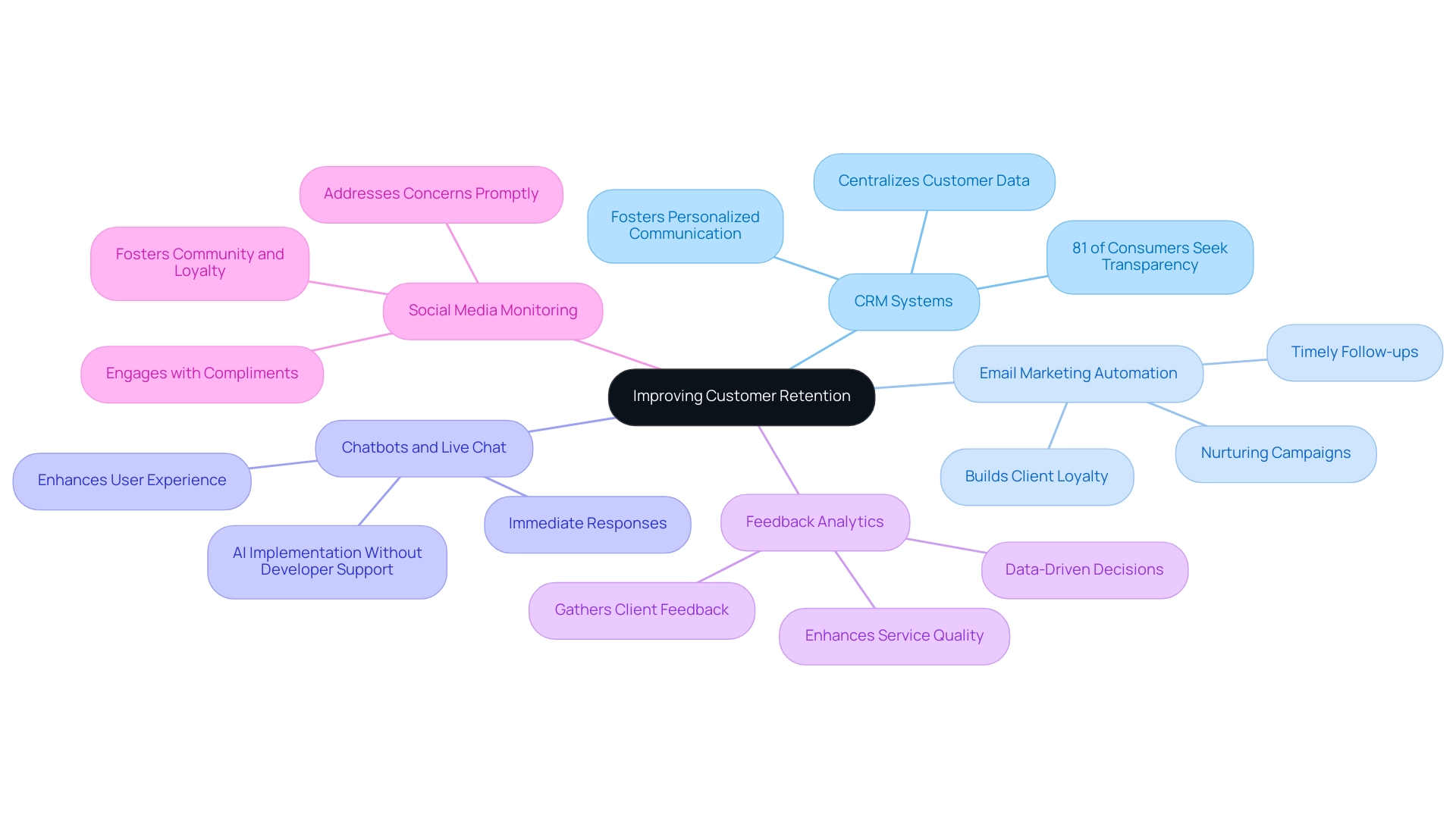
Nurture customer loyalty and increase retention with Dashly:
The role of customer feedback in retention strategies
Client feedback is truly the foundation of effective customer retention management strategies, providing businesses with invaluable insights that can significantly enhance the customer experience and foster loyalty. When clients are involved in feedback processes, it not only helps in recognizing their needs but also nurtures a deeper connection with the brand. As Sam Walton famously said, “There is only one boss. The client. And he can fire everybody in the company from the chairman on down, simply by spending his money somewhere else.” Here are several effective methods to gather and utilize customer feedback in 2025:
- Surveys and polls: Implementing surveys is crucial for obtaining direct feedback on client satisfaction and expectations. Platforms like SurveyMonkey and Google Forms make this process easier, allowing organizations to collect and analyze responses effectively. Research shows that client satisfaction surveys have proven to be significantly effective in customer retention management, with numerous companies reporting enhanced retention rates after implementation.
- Net Promoter Score (NPS): Utilizing NPS surveys is an excellent way to measure client loyalty and satisfaction. This metric not only helps identify areas needing improvement but also assesses the likelihood of clients recommending your business to others. With 81% of consumers acknowledging the role of AI in improving service, integrating AI tools can further streamline the analysis of NPS results, leading to actionable insights. In fact, 81% of consumers believe AI is now a part of modern service, underscoring the importance of these tools in feedback processes.
- Feedback loops: Establishing a continuous feedback loop is vital for regularly collecting and acting on client opinions. This approach demonstrates to clients that their voices are heard and valued, cultivating a sense of partnership. It’s essential for companies to respond to feedback swiftly, as this responsiveness can greatly influence their customer retention management.
- Social listening: Monitoring social media channels for brand mentions and discussions offers real-time insights into audience sentiment. By actively engaging with clients on these platforms, companies can address issues proactively and promote a more tailored client experience. Notably, the top 10% of returning clients spend twice as much per order, highlighting the financial impact of effective client engagement strategies.
Integrating these approaches into your loyalty system not only enhances client satisfaction but also strengthens brand allegiance, ultimately driving long-term business growth through effective customer retention management. Additionally, remember that client loyalty rates vary by sector; for instance, media and professional services average 84%, while e-commerce stands at 38%. Understanding these nuances can help you customize your approach to feedback and retention methods effectively.
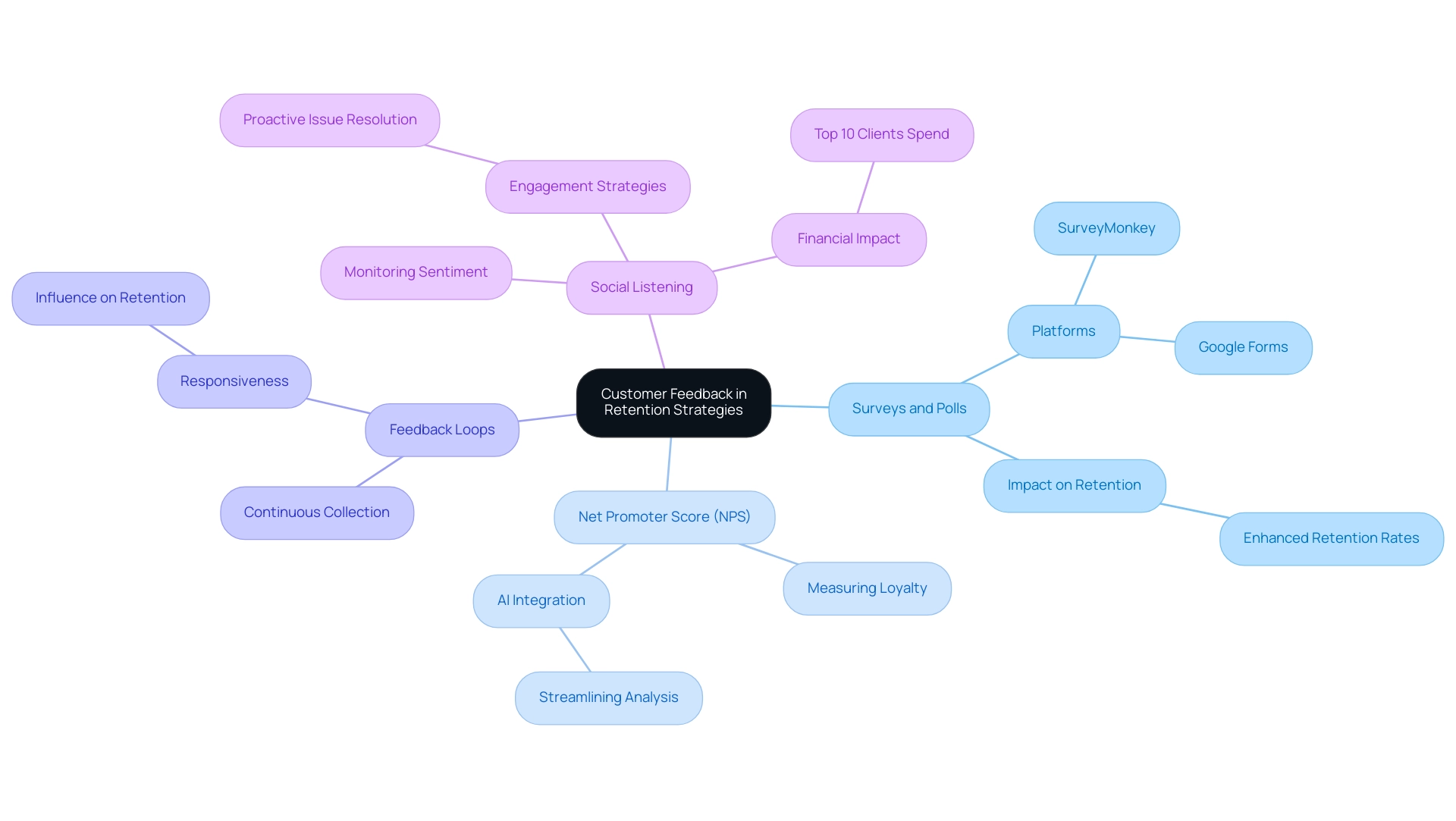
Creating personalized experiences to foster loyalty
Creating personalized experiences is essential for customer retention management and nurturing client loyalty. We understand that running a business can be challenging, and personalizing your approach can feel overwhelming. Here are some effective strategies to help you implement personalization in your business:
- Tailored recommendations: By utilizing client data, you can offer personalized product suggestions based on prior purchases and browsing behavior. This not only enhances user satisfaction but also drives engagement, as personalized recommendations can significantly increase conversion rates.
- Customized marketing campaigns: Segment your audience into distinct groups and develop targeted marketing initiatives that address their unique needs and interests. This strategy enhances customer retention management by enabling more relevant messaging, fostering a deeper connection with clients. Research shows that companies that grow faster generate 40% more of their revenue from personalization than their slower-growing counterparts, highlighting the financial benefits of tailored marketing.
- Personalized onboarding: Design onboarding experiences that are customized for each individual. By guiding them through your product or service in a way that resonates with their specific needs, you ensure they understand its value and usage, ultimately leading to higher satisfaction rates.
- Unique client interactions: Incorporate names and personal details during interactions to create a welcoming and personable atmosphere. This practice makes clients feel recognized and valued, enhancing their overall experience and loyalty.
- Client Journey Mapping: Conduct a thorough analysis of the client journey to pinpoint key touchpoints where personalization can be applied. By enhancing these interactions with tailored content or offers, you significantly improve customer retention management and the overall client experience.
However, despite the clear advantages of personalization, organizations must navigate challenges in experience management. Issues such as poor service, siloed teams, and technical limitations can hinder efforts to create a seamless experience. By tackling these challenges using tools like Dashly‘s integrated omnichannel communication, AI support bot, and performance analytics, businesses can ensure timely and tailored interactions that encourage deeper client engagement.
As organizations implement these strategies for customer retention management, they can anticipate a significant rise in client loyalty rates. In fact, purchase and engagement rates in a multichannel experience are 250% greater than those in single-channel campaigns, with loyalty skyrocketing to 90% higher. Dashly’s features, including saved replies and comprehensive analytics, play a crucial role in achieving these higher retention rates by streamlining support processes and providing valuable insights into client interactions.
By prioritizing personalization and proactive engagement with Dashly’s solutions, organizations can enhance their customer retention management, cultivating lasting relationships with their clients that translate into both client loyalty and improved financial performance.
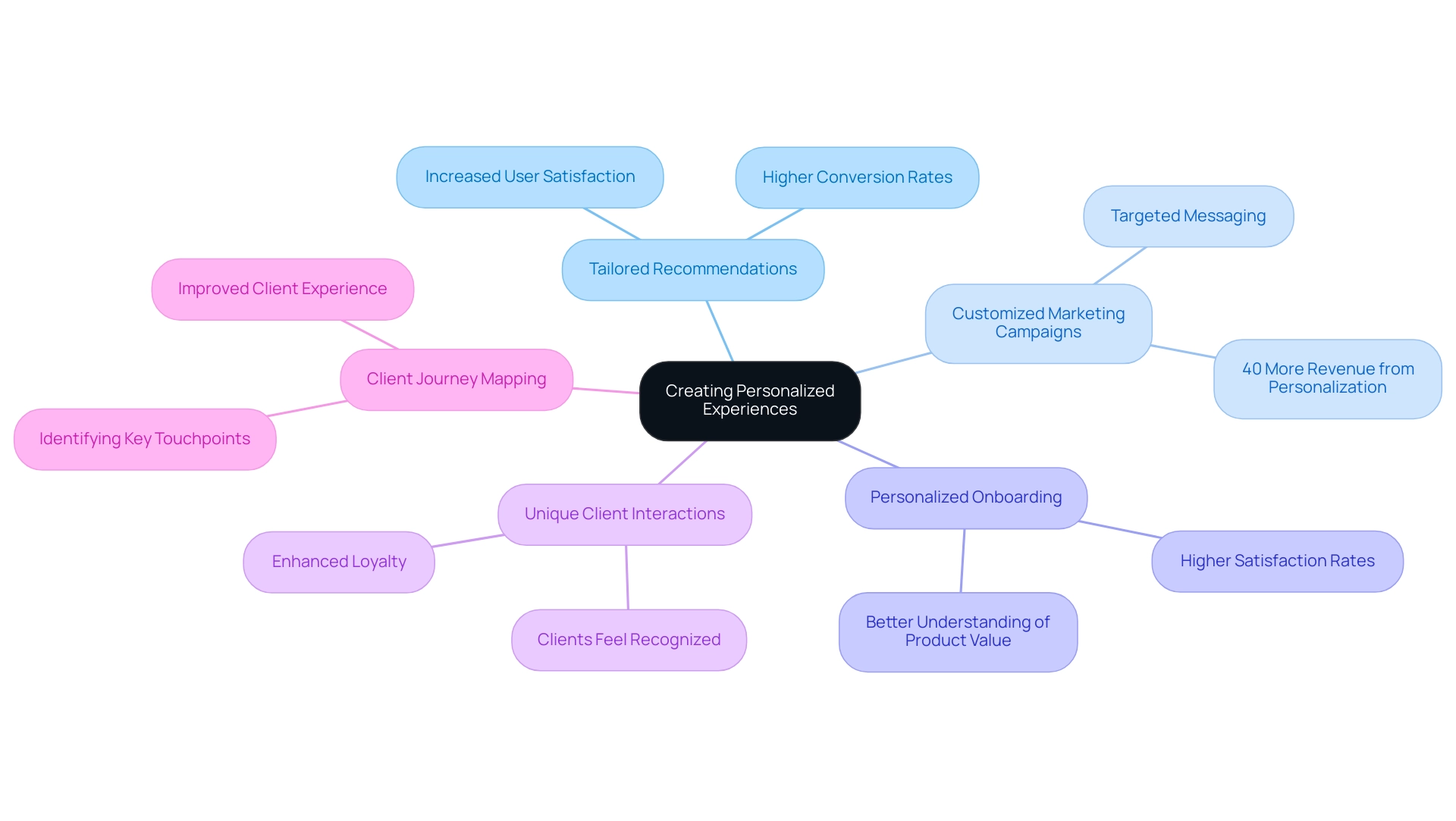
Long-term benefits of mastering customer retention management
Mastering Customer Retention Management offers small businesses a pathway to long-term success, addressing real challenges you face daily:
Increased Client Lifetime Value (CLV): It’s no secret that retained clients tend to spend more over time. Research shows that this leads to a significant boost in their lifetime value, enhancing your revenue while allowing you to forge deeper connections with your clientele.
Lower acquisition costs: Focusing on client retention can drastically reduce the expenses tied to acquiring new clients. This strategic shift allows you to allocate your budget more wisely — investing in enriching client experiences and honing your customer retention management instead of constantly pursuing new leads.
Enhanced brand loyalty: Your loyal clients can transform into passionate advocates, spreading the word about their positive experiences through referrals and reviews. As Mara Calvello, Content and Communications Manager at G2, puts it,
Attending to the right query at the right time without giving way to consumer frustration can ignite feelings of brand loyalty and reputation. Furthermore, statistics reveal that 74% of clients feel more loyal when they believe their voices are heard, underscoring the importance of timely and effective service in nurturing that loyalty.Sustainable growth: A loyal clientele creates a steady revenue stream, empowering you to invest in growth initiatives and explore new opportunities. By implementing strategies that enhance customer retention management, you can achieve lasting growth and adaptability in a competitive marketplace. For instance, the case study titled “Building Client Communities” illustrates how fostering client communities can boost loyalty by 54%, advocacy by 50%, and satisfaction by 46%.
Incorporating these strategies not only brings immediate benefits but also positions your small business for ongoing success in a dynamic market. Remember, you’re not alone in navigating these challenges—each step you take towards mastering customer retention will pave the way for a brighter future.
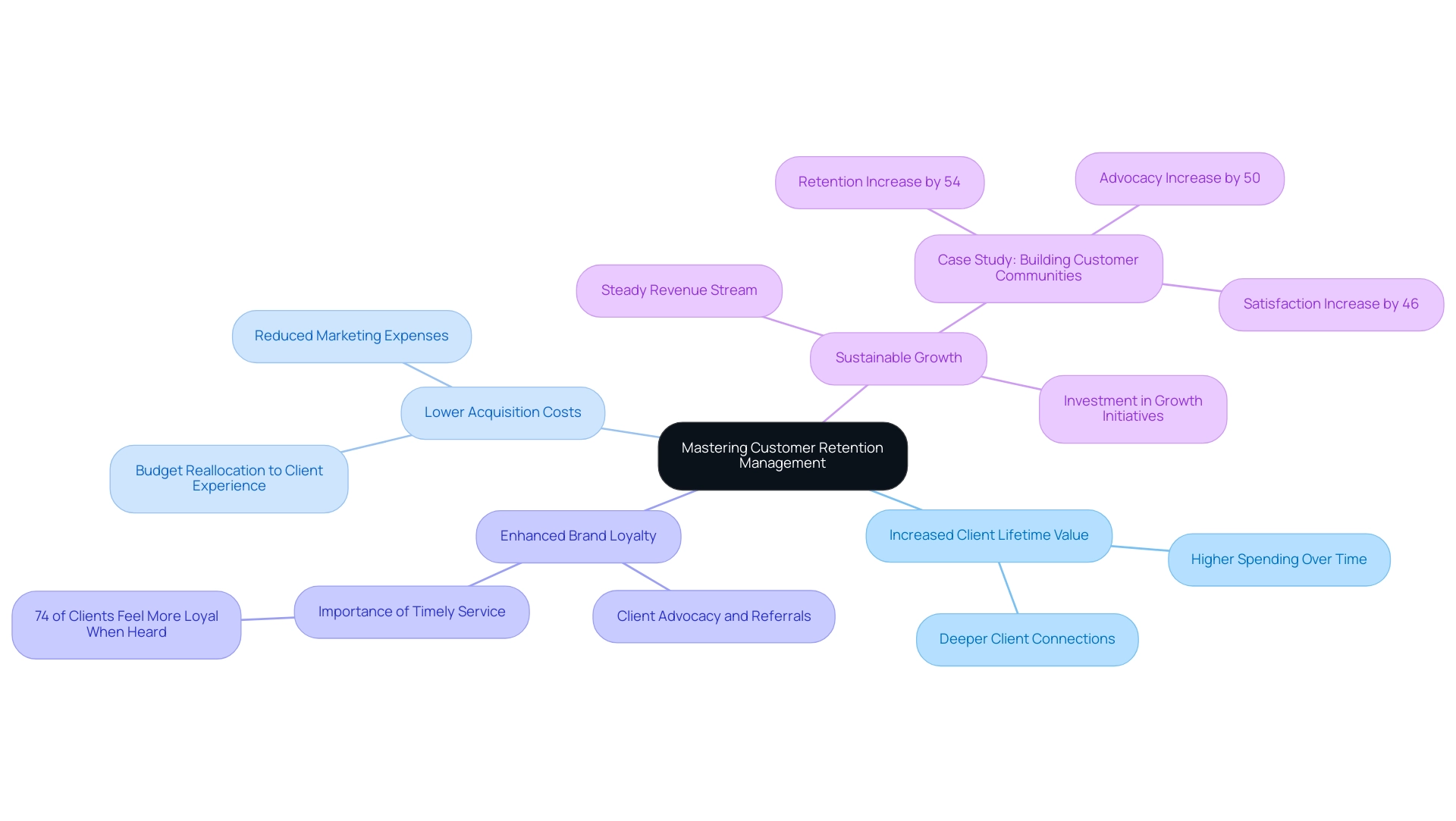
Implementing customer retention strategies in your business
Applying efficient customer retention management approaches is crucial for any small enterprise seeking to thrive in today’s competitive landscape. We understand that navigating this terrain can be daunting, and that’s why we’re here to guide you through some essential steps that can make a real difference:
- Assess current customer retention rates: Start by taking a close look at your existing metrics. This analysis will provide a clear picture of where your business stands, helping you pinpoint specific areas for improvement and shaping your future strategies.
- Set clear goals: With your analysis in hand, define specific objectives for retaining customers. Whether you aim to reduce churn rates or enhance client satisfaction scores, having measurable goals will keep you focused and allow you to assess your success along the way.
- Engage your team: Cultivating a customer-centric culture is vital, and involving your team in loyalty initiatives is key. When employees understand client needs and expectations, it fosters a sense of ownership. Studies reveal that three out of five clients consider excellent service essential to their loyalty. Moreover, SAP Emarsys found that 53% of respondents are silent loyalists, meaning they remain loyal to brands without actively engaging. Recognizing this dynamic can help you tailor your strategies effectively.
- Leverage AI-driven support tools: Consider utilizing Dashly’s AI support bot and automation solutions to streamline interactions. Features like a shared inbox for managing queries from various platforms enable support agents to respond more swiftly while maintaining context. Additionally, Dashly’s analytics tools allow you to monitor service performance across all channels, identify benchmarks for response times, and uncover opportunities for improvement. With the AI support bot handling up to 40% of user inquiries, your team can dedicate more time to complex client matters, enhancing overall engagement.
- Monitor progress: Regularly track the effectiveness of your retention strategies using analytics tools. This ongoing monitoring will help you understand what’s working in customer retention management and where adjustments may be necessary. Embracing this iterative process is vital for maintaining a proactive approach.
- Adapt and evolve: Stay flexible and be ready to adjust your strategies based on client feedback and market trends. For instance, in April 2023, 35% of shoppers indicated that marketplaces were their preferred e-commerce channel, reflecting a shift in consumer preferences. By being attentive to your clients’ evolving needs, you can ensure that your customer retention efforts remain relevant and effective.
As you implement these strategies, keep in mind that boosting customer loyalty rates by just 5% can lead to a profit increase of between 25% and 95%. This significant financial impact is illustrated in the case study titled ‘Financial Impact of Customer Loyalty,’ which shows how minor enhancements in customer loyalty can yield substantial profit growth. By leveraging Dashly’s tools, you can directly influence these outcomes, transforming your commitment to retention into a strategic business decision.
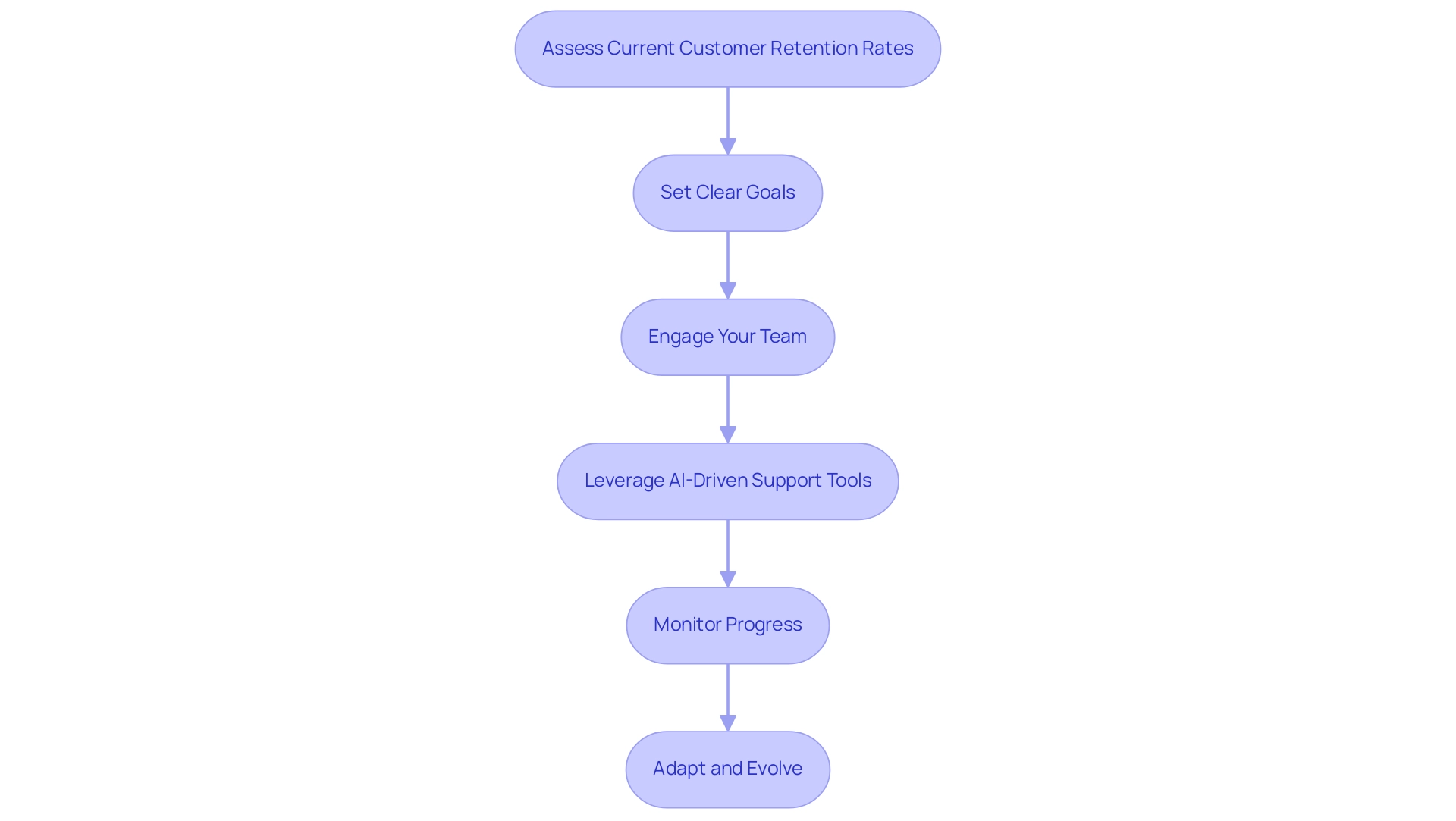
Conclusion
Mastering Customer Retention Management is not just important — it’s essential for small businesses striving for success in a competitive marketplace. We understand the daily challenges you face, and cultivating customer loyalty through effective CRM strategies can be your key to reducing churn and enhancing profitability. By prioritizing customer retention over acquisition, you can significantly lower costs and foster long-term relationships that drive repeat purchases and referrals.
Implementing personalized communication, loyalty programs, exceptional customer service, and regular follow-ups are pivotal strategies for enhancing retention. Have you considered how leveraging technology — like CRM systems, email marketing automation, and feedback analytics — can streamline your interactions and provide valuable insights into customer preferences? Incorporating customer feedback mechanisms solidifies your connection with clients, enabling you to adapt and evolve based on their voices.
Ultimately, a well-executed customer retention strategy not only secures immediate benefits but also builds a foundation for sustainable growth. By focusing on nurturing relationships and delivering exceptional experiences, you can position your business for long-term success. This approach ensures a steady revenue stream and enhances brand loyalty in an ever-evolving market landscape. Embracing these principles is not just beneficial; it is crucial for thriving in today’s business environment. Remember, you’re not alone in this journey — small steps can lead to significant results.






